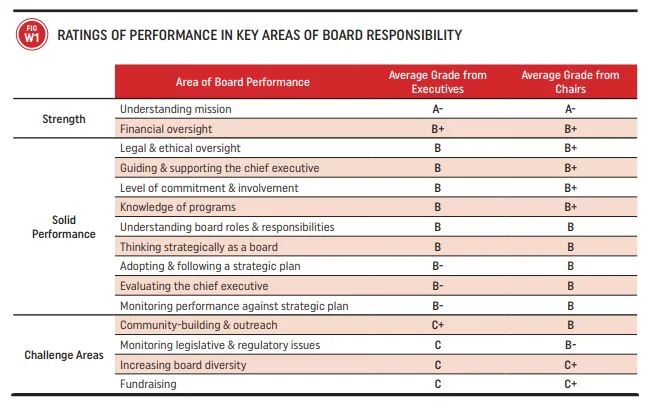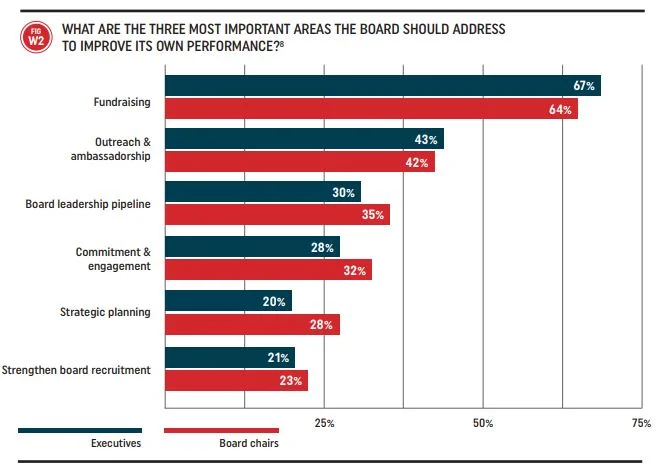COURAGEOUS CONVERSATIONS WE NEED TO HAVE - PART III - YOUR BOARD’S IMPACT ON ORGANIZATIONAL PERFORMANCE
COURAGEOUS CONVERSATIONS WE NEED TO HAVE - PART III - YOUR BOARD’S IMPACT ON ORGANIZATIONAL PERFORMANCE
Andrea McManus, ViTreo Group Inc
March 26th 2019
Some of the most important courageous conversations not for profit organizations need to have are about their boards and with their boards. For many charitable organizations, the impact the board has on organizational performance could be greater. Much greater. As I said in my first blog in this Courageous Conversation Series:
When we talk about boards, we often address board governance. So, what does that mean? Nonprofit Quarterly defines it as:
“Nonprofit governance has a dual focus: achieving the organization’s social mission and ensuring the organization is viable. Both responsibilities relate to fiduciary responsibility that a board of trustees (sometimes called directors, or Board, or Management Committee - the terms are interchangeable) has with respect to the exercise of authority over the explicit actions the organization takes. Public trust and accountability is an essential aspect of organizational viability, so it achieves the social mission in a way that is respected by those whom the organization serves and the society in which it is located.”
- Nonprofit Quarterly, What is Governance?, The Editors, June 09 2017 - 03/21/19
Good governance is critical to charitable organizations in these days of reduced funding, competition and increased demand for services. There is more focus on accountability and expectations for boards, as well as challenges in recruiting quality board members who may be concerned about liability (Deloitte LLP, The Effective Not For Profit Board — A Value Driving Force, 2013).
If the role of the board in providing strong governance is to help the organization achieve its mission, then it stands to reason it must have a deep understanding of that mission or purpose. Without this, board members can’t lead effectively. The board needs to understand what the work is.
In its report, Leading with Intent: 2017 National Index of Nonprofit Board Practices, BoardSource’s research found that boards received only average grades on understanding their roles and responsibilities. The data from the study shows a clear correlation between how “a board’s understanding of its roles and responsibilities relates to strong board performance in other areas and the perception of the board’s impact on organizational performance.” The report goes on to state that “37 percent of executives and 25 percent of chairs give their boards a C grade or below in this area.” (BoardSource, Leading with Intent, 2017)
That’s a high percentage of executives and chairs awarding their boards dismal grades in this area. Clearly, there is a need to have conversations about this within organizations and with boards.
One of the other findings in the Leading with Intent report was a strong relationship between the board’s role in strategy and organizational performance. Yes!
When a board followed and adopted a strategic plan and monitored the not for profit’s performance against the plan’s objectives, there was a positive impact. However, BoardSource’s research found:
“Boards are not fully engaging in strategy. Eighty-four (84) percent of organizations report they have a written strategic plan, but fewer report their boards are doing well in their broader strategic role. Of the organizations with written strategic plans, executives report room for improvement in several key strategic functions….Only 54 percent report the board is good at monitoring organizational performance against the strategic plan…. Just 26 percent report board meetings focus on strategy and policy versus operational issues.”
How would you rate your not for profit’s board in this area? Would you give it a passing grade or…?
What are some methods you would want to include in a conversation about and with your board to strengthen the board’s performance? A comprehensive orientation for new board members and ongoing education for existing members, as well as discussion during the recruitment process, would leverage the board’s impact. Your board should self evaluate and engage in ongoing reviews of strategy to determine what is working and what is not.
Another conversation that must take place with boards is about their role in fundraising. Not for profit boards must be seen to be giving, both internally and externally. How can you convince others to give, if your own board is not providing support? In last week’s, The Provocateur, on philanthropic orientation, I wrote about how the responsibility for the development of philanthropy must not lie only with the fundraising team, but that everyone including board members must be engaged and active in supporting fundraising.
A third critical conversation is about the role of boards as advocates and ambassadors — but they must first understand the work of the not for profit. According to Board Source, “Boards are starting to embrace their roles as advocates for their missions, but stronger leadership is still needed. More than half of all boards are actively working in concert with staff leadership to educate policymakers on behalf of their organization, but most organizations do not have formal policies around advocacy. Both chief executives and board chairs cite board member ambassadorship as a top three area for board improvement….Strong understanding of programs is linked to stronger engagement, strategy, and external leadership — including fundraising.” (BoardSource, Leading with Intent, 2017)
Again, BoardSource’s research indicates that boards struggle with their external roles, “Conversely, they struggle most with external responsibilities, including fundraising, advocacy, and community-building and outreach. These trends are reflected, in both the overall ratings of board performance…and the indications of the most important areas for board improvement.” (BoardSource, Leading with Intent, 2017)
Not for profit boards must also be willing to have difficult conversations on behalf of their organizations, but few do so.
“For many nonprofits, their work is bounded, limited, and facilitated by public policy, yet according to the index, few boards see themselves as responsible for monitoring the impact of public policy on their organization; 37% do, at least to “some extent,” and this category is sensitive to size, with smaller organizations doing less of it. Even fewer, 33%, try to affect policy by educating policymakers “to some extent.”
Board conversations can be powerful, frightening and difficult. And they require a CEO to be ready to support the board. Many CEOs are often not prepared for a positive outcome in this conversation.
All of this goes to underscore how critical board impact and engagement are to our not for profits’ abilities to fulfill their purpose and to build their influence. We must help our boards to develop a deeper comprehension of the work we do and the impact we have. And to do that, we must have these conversations.
Which one will you have first?
Check out ViTreo's Braintrust as we bring you additional insights into what is and what will be important in philanthropy through our Weekly News Recap and our Podcast.
ABOUT THE AUTHOR
Andrea McManus, Chair, Board of Directors, Partner
ViTreo Group Inc
Andrea McManus is a Partner with ViTreo with over 30 years’ experience in fund development, marketing, sponsorship and nonprofit management. A highly strategic thinker and change maker, Andrea has worked with organizations that span the nonprofit sector with particular focus on building long-term and sustainable capacity.






